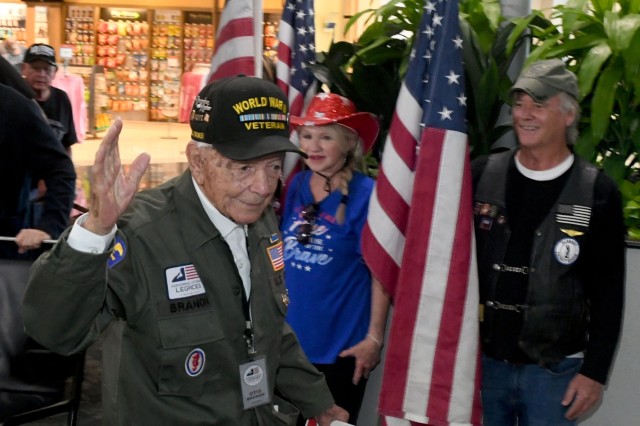
REDSTONE ARSENAL, Ala. — Last June, Otis Branon visited the windswept Omaha and Utah beaches where American troops landed on D-Day and the Normandy American Cemetery that contains the graves of nearly 9,400 war dead.
Branon, at 97, returned to France last week with two other World War II veterans as part of Honoring Veteran Legacies’ Legacy Trip to Normandy in observance of the 80th anniversary of D-Day. The day before leaving, he recalled that solemn journey to the historic sites in France.
“When you go to a military graveyard where almost 10,000 Americans are buried and stand on some of the battlefields, it’s very moving,” he said. “Lots of guys that got drafted at 18 left their homes on a train or bus on their way to basic training. They were sent off to the war zones and they wouldn’t come back home, they died. Most of (their parents) were not able to finance (a trip) to go to France to see the graves.”
Branon returned to pay his respects for those who couldn’t. “That’s one reason I go.”
Branon, from Warrior, Alabama, was just 17 when he volunteered to serve in the Army in 1944.
“Everybody that could joined,” said Branon, who before leaving married Audie Louise, his wife for 63 years until her death in 2007. He went to Fort McClellan for basic training and then on to Coronado Island, California where he learned to operate and maintain Higgins boats, the landing craft that carried troops and vehicles to shore in World War II; and crash boats, high-speed boats designed to rescue the crews of aircraft which crashed at sea.
After that training, Branon was assigned to the 532nd Amphibious Engineers Special Brigade in the Pacific Theater and went to Luzon, the largest island in the Philippines.
With some hesitancy, he talks about a brush with the enemy there.
He was staying in a secured area and, not long after arriving, he and two others were sent out to track down a Japanese sniper who was killing Americans.
“When somebody tells you you’re going out in the jungle to track somebody, that’s not a good feeling,” Branon said. “(The sniper) moved around a lot. They called him Checkerboard Charlie.”
The three men set out around daybreak one day and, at around noon, they stopped for a break and sat on the limb of a dead coconut tree that had fallen across a trail.
“I heard a click (from a rifle) and this guy was standing on the trail about 200 to 300 feet away,” Branon said. Quickly, Branon pulled his own rifle, and “I fired four times,” killing the sniper.
After leaving Luzon, Branon, an Army corporal, participated in two island invasions. Iwo Jima, where a first cousin was killed, and Okinawa, traveling back and forth to perform his duty as a boat mechanic.
“We set up on shore to work on the boats. We kept the boats running. That was my major job.”
After the atomic bombs were dropped in Japan, Branon’s unit was among the first on the ground into Hiroshima. “They sent us over there to secure the place,” he said. “I guess I’m the only one I know that’s still alive that walked there.”
He later traveled to Aomori by train and recalled the destruction he saw. In that city, “there was nothing left up there except a train station and a public bathhouse.” he said.
“The worst thing in my life that I’ve ever witnessed was kids starving,” he said, noting that while in Aomori, he saw children lining up to go through rice fields looking for grains of rice.
“You’d see kids actually starving to death. That’s a bad, bad scene.”
Though Branon was encouraged to continue serving in the military, he left the Army in 1946.
When he returned home, he earned a cryogenic engineering degree from the University of Alabama in Birmingham through the G.I. Bill. In 1951, he joined Union Carbide, where he worked for about 34 years and was a general superintendent at several plants. Branon now lives in New Hope, with two daughters living nearby.
Chris Batte, the co-founder and president of Honoring Veteran Legacies, said the veterans and 11 others will spend two days in Paris before heading to Normandy for the remainder of the trip.
The group is scheduled to return home June 12.
The veterans will travel with four family members, including Branon’s grandson, Jason Otis Smith, two medical staff and five volunteers, including one Vietnam veteran and one Desert Storm-era veteran.
“I told my grandson, when I carried him (to college), when you leave here you’ll be a different person. And of course I told him, when you go to France and you go out on those beaches, you’ll have a different outlook on life.”

Social Sharing